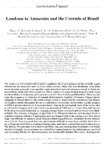Please use this identifier to cite or link to this item:
http://www.alice.cnptia.embrapa.br/alice/handle/doc/1030465Full metadata record
| DC Field | Value | Language |
|---|---|---|
| dc.contributor.author | NEPSTAD, D. C. | pt_BR |
| dc.contributor.author | KLINK, C. A. | pt_BR |
| dc.contributor.author | UHL, C. | pt_BR |
| dc.contributor.author | VIEIRA, I. C. | pt_BR |
| dc.contributor.author | LEFEBVRE, P. | pt_BR |
| dc.contributor.author | PEDLOWSKI, M. | pt_BR |
| dc.contributor.author | MATRICARDI, E. | pt_BR |
| dc.contributor.author | NEGREIROS, G. | pt_BR |
| dc.contributor.author | BROWN, I. F. | pt_BR |
| dc.contributor.author | AMARAL, E. | pt_BR |
| dc.contributor.author | HOMMA, A. | pt_BR |
| dc.contributor.author | WALKER, R. | pt_BR |
| dc.date.accessioned | 2015-12-03T11:11:11Z | pt_BR |
| dc.date.available | 2015-12-03T11:11:11Z | pt_BR |
| dc.date.created | 2015-12-03 | pt_BR |
| dc.date.issued | 1997 | pt_BR |
| dc.identifier.citation | Ciência e Cultura, São Paulo, v. 49, n. 1/2, p. 73-86, 1997. | pt_BR |
| dc.identifier.uri | http://www.alice.cnptia.embrapa.br/alice/handle/doc/1030465 | pt_BR |
| dc.description | The total area and annual rate of native vegetation clearing is greatest in the Cerrado region followed by the Brazilian states of Para, Mato Grosso, Maranhao and Rondonia. Amazonian forest clearing proceeds most quickly where abundant natural resources (wood or land) are accessible by roads and close to markets. These regions are concentrated along the eastern and southern flanks of Amazonia, particularly in eastern Para, Cuiaba and Rondonia. There are still large discrepancies in estimates of annual deforestation; Landsat (Thematic Mapper-based) mapping of deforestation in the closed-canopy forests of Amazonia has not include non-Brazilian countries and is incomplete for the cerrado biome. Amazonian deforestation was last mapped 1994. Current estimates of Amazonian forest clearing do not include most of the forests that are affected by logging each year, which is an area (about 7,000 km2 yr-1)more than half the size of the area of annual deforestation. Logging changes forest structure and increases forest flammability. The intensity of logging ranges from 1-to 100-species harvest, and averages 20m3 of wood harvested per hectare. Logging may increase dramatically in the coming years. Fire affects large, but difficult to measure, areas of pastureland, logged forests, secondary forests and primary forests. Forest ground fires are particularly difficult to map fom satellite data. Fire is more frequent where forest clearing is taking place, and where seasonal drought is most severe. The destiny of Amazonian forest land cleared for crops and cattle pasture is complex, and highly variables regionally. Areal estimates are needed for managed pasture, degraded pasture, cropland and secondadry forests, for these ecosystems are functionally distinct. Most forest clearing is for pasture establishment, followed by shifting cultivation. Cattle pasture is the logical land-use for both small-scale and large-scale rural Amazonians because cattle are easily sold or traded, and they maintain their value during inflation. Cattle patures help secure land claims and increase land value. In the Cerrado, there has been a shift from extensive cattle grazing of natural savannas to pasture planted with African forage grasses; mechanized soy bean production is the second most extensive land-use. Pastures are the most important land-cover for the LBA (Large-Scale Biosphere - Atmosphere experiment in Amazonia) science campaign. Brazilian Amazonia experiences reduced rainfall during ENSO events. ENSO-related drought is most severe in eastern Amazonia. A basin-wide reduction in rainfall would have its greatest affect on vegetation near the border between savanna and closed-canopy forest in Rondonia, Mato Grosso, Para and Tocantins. The LBA campaign should be conducted in variety of rural landscapes to capture the multiplicity of human effects on native ecosystems, as well as the range of cliamatic and edaphic conditions under which these ecosystems have evolved. It should address the current (ENSO) and predicted variations in climate, and should be designed to recommend those land-uses that best reconcile the maintenance of ecosystem processes with socially equitable economic growth. | pt_BR |
| dc.language.iso | eng | eng |
| dc.rights | openAccess | eng |
| dc.subject | Brasil | pt_BR |
| dc.subject | Enviromental impact | pt_BR |
| dc.title | Land-use in Amazonia and the cerrado of Brazil. | pt_BR |
| dc.type | Artigo de periódico | pt_BR |
| dc.date.updated | 2020-02-17T11:11:11Z | pt_BR |
| dc.subject.thesagro | Cerrado | pt_BR |
| dc.subject.thesagro | Impacto Ambiental | pt_BR |
| dc.subject.thesagro | Uso da Terra | pt_BR |
| dc.subject.nalthesaurus | Amazonia | pt_BR |
| dc.subject.nalthesaurus | Brazil | pt_BR |
| dc.subject.nalthesaurus | land use | pt_BR |
| riaa.ainfo.id | 1030465 | pt_BR |
| riaa.ainfo.lastupdate | 2020-02-17 -03:00:00 | pt_BR |
| dc.contributor.institution | DANIEL C. NEPSTAD, Woods Hole Research Center / UFPA; CARLOS A. KUNK, UNB; CHRISTOPHER UHL, Pennsylvania State University / IMAZON; IMA C. VIEIRA, MPEG; PAUL LEFEBVRE, UNB; MARCOS PEDLOWSKI, Virginia Polvtechnic tnstitute; ERALDO MATRICARDI, Secretaria de Desenvolvimento Ambiental, Porto Velho, RO; GUSTAVO NEGREIROS, Universitv of Washington; IRVING F. BROWN, Woods Hole Research Center / UFF; EUFRAN AMARAL, UFAC; ALFREDO KINGO OYAMA HOMMA, CPATU; ROBERT WALKER, Florida State University. | pt_BR |
| Appears in Collections: | Artigo em periódico indexado (CPATU)  | |
Files in This Item:
| File | Description | Size | Format | |
|---|---|---|---|---|
| Landuse.pdf | 812,74 kB | Adobe PDF |  View/Open |









